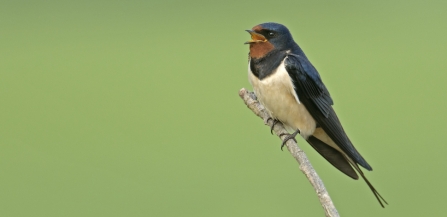Every year, visitors flock to the reserve, which provides the perfect roosting and refuelling point for the birds as they travel south from across the north of the UK. Figures collected by Derbyshire Wildlife Trust suggest that the reserve supports between 10 and 15,000 individual swallows at this time, which is around 4 % of the total UK population.
The agile and much loved swallow, identified by a long forked tail and happy chirruping call returns to South Africa after spending the summer in the UK to breed. The UK population is around 375,000 pairs but conservationists are increasingly concerned about their declining numbers. The decline is thought to be due to a changing climate, adverse weather during migration, declining insects and places to nest.
Tim Birch of Derbyshire Wildlife Trust, who manage the reserve on behalf of The Land Trust said: “it’s humbling to watch these smart birds gather together, knowing the epic journey they have ahead of them. Some birds are still just a few weeks old and making the journey for the first time. Sadly, their numbers are in decline and we need to do all we can to help them. Before making the 6000 mile trip back to South Africa, they need to rest and refuel on flying insects so the reedbeds and grassland of The Avenue Washlands are ideal.”
The reserve was created in 2005 and includes reedbed, marsh, ponds and meadow in the valley of the River Rother on part of the site of the decommissioned Avenue Coking Works. Derbyshire Wildlife Trust have worked closely with owners the Land Trust to restore the site and create a rich wildlife habitat with further plans for extension, new and improved wildlife habitat and open space amenities for local people.
The reserve has also become a haven to other wildlife including tufted duck, wigeon, snipe and little grebe as well as skylarks, yellowhammer and nesting warblers, water voles, great crested newts and dragonflies. Elusive and rare bittern have also been spotted here.
The swallows will return next April.

